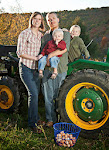 My wife was up town catching a very earlier breakfast with a friend when I was awoken by a text message from her asking where the tornado was. The power was off, there was a lot of lighining, and the wind chimes on the porch were blowning in the breeze. Then there was a steady roar like a jet engine, and I quickly threw on some overalls and grabbed the boys, some pillows and blankets, and we waited in the darkness for 5 minutes or so in the hall. If you've never woken up a 2 yr old and a 9 month old when there's an abscence of power but an abundance of full diapers - well the experience is pretty much how you'd think, except the leg the baby's on gets progressively warmer.
My wife was up town catching a very earlier breakfast with a friend when I was awoken by a text message from her asking where the tornado was. The power was off, there was a lot of lighining, and the wind chimes on the porch were blowning in the breeze. Then there was a steady roar like a jet engine, and I quickly threw on some overalls and grabbed the boys, some pillows and blankets, and we waited in the darkness for 5 minutes or so in the hall. If you've never woken up a 2 yr old and a 9 month old when there's an abscence of power but an abundance of full diapers - well the experience is pretty much how you'd think, except the leg the baby's on gets progressively warmer.The power came on about an hour later, and the local news (channel 5 their pics are in the post) let us know of the destruction over towards Cincinnati. We've got a friend over there that's a pastured poultry farmer and we got started with poultry on pasture at the same time. She'd slept through the storm, only waking up after the power went out as well. She lives around a mile from Cincinnati, and when I told her the fire station had been destroyed, she remarked that was near so and so's dairy.
 Turns out the old man who farmed the dairy was milking the cows when the storm struck. Sadly, there's one less dairy farmer in Washington County going into 2011.
Turns out the old man who farmed the dairy was milking the cows when the storm struck. Sadly, there's one less dairy farmer in Washington County going into 2011.The irony with these crazy winter storms is that the day is always so pretty afterwards. It was a beautiful day, and Carla and I got to get out and work around the house together - me in the garden and Carla brush-eating across the road.
Here's to a storm-free 2011













